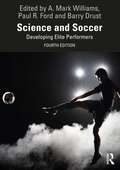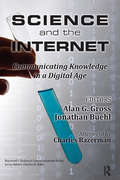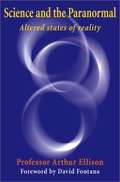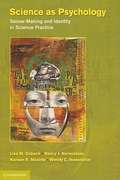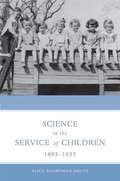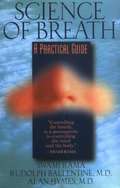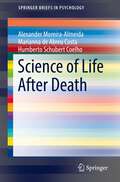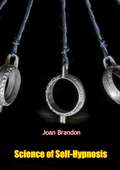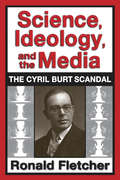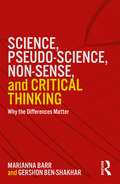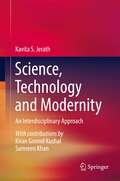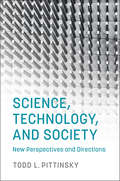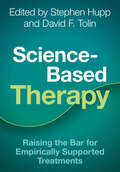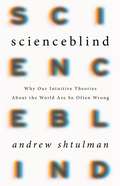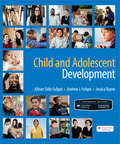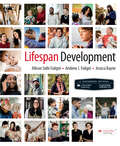- Table View
- List View
Science and Soccer: Developing Elite Performers
by A. Mark Williams Barry Drust Paul R. FordNow in a fully revised and updated fourth edition, Science and Soccer is still the most comprehensive and accessible introduction to the physiology, biomechanics and psychology behind the world's most popular sport. Offering important guidance on how science translates into practice, the book examines every key facet of the sport, with a particular focus on the development of expert performers. The topics covered include: • anatomy, physiology, psychology; sociology and biomechanics; • principles of training; • nutrition; • physical and mental preparation; • playing surfaces and equipment; injury • decision-making and skill acquisition; • coaching and coach education; • performance analysis; • talent identification and youth development. Science and Soccer: Developing Elite Performers is a unique resource for students and academics working in sports science. It is essential reading for all professional support staff working in the game, including coaches at all levels, physiotherapists, conditioning specialists, performance analysts, club doctors and sport psychologists.
Science and Spiritual Practices: Reconnecting through direct experience
by Rupert SheldrakeIn this pioneering book Rupert Sheldrake shows how science helps validate seven practices on which all religions are built, and which are part of our common human heritage:· Meditation· Gratitude· Connecting with nature· Relating to plants· Rituals· Singing and chanting· Pilgrimage and holy places. The effects of spiritual practices are now being investigated scientifically as never before, and many studies have shown that religious and spiritual practices generally make people happier and healthier. Rupert Sheldrake summarizes the latest scientific research on what happens when we take part in these practices, and suggests ways that readers can explore these fields for themselves. For those who are religious, Science and Spiritual Practices will illuminate the evolutionary origins of their own traditions and give a new appreciation of their power. For the non-religious, this book will show how the core practices of spirituality are accessible to all, even if they do not subscribe to a religious belief system. This is a book for anyone who suspects that in the drive towards radical secularism, something valuable has been left behind. Rupert Sheldrake believes that by opening ourselves to the spiritual dimension we may find the strength to live more wholesome and fulfilling lives.
Science and Spiritual Practices: Reconnecting through direct experience
by Rupert SheldrakeIn this pioneering book Rupert Sheldrake shows how science helps validate seven practices on which all religions are built, and which are part of our common human heritage:· Meditation· Gratitude· Connecting with nature· Relating to plants· Rituals· Singing and chanting· Pilgrimage and holy places. The effects of spiritual practices are now being investigated scientifically as never before, and many studies have shown that religious and spiritual practices generally make people happier and healthier. Rupert Sheldrake summarizes the latest scientific research on what happens when we take part in these practices, and suggests ways that readers can explore these fields for themselves. For those who are religious, Science and Spiritual Practices will illuminate the evolutionary origins of their own traditions and give a new appreciation of their power. For the non-religious, this book will show how the core practices of spirituality are accessible to all, even if they do not subscribe to a religious belief system. This is a book for anyone who suspects that in the drive towards radical secularism, something valuable has been left behind. Rupert Sheldrake believes that by opening ourselves to the spiritual dimension we may find the strength to live more wholesome and fulfilling lives.
Science and Spiritual Practices: Reconnecting through direct experience
by Rupert SheldrakeIn this pioneering book Rupert Sheldrake shows how science helps validate seven practices on which all religions are built, and which are part of our common human heritage:· Meditation· Gratitude· Connecting with nature· Relating to plants· Rituals· Singing and chanting· Pilgrimage and holy places. The effects of spiritual practices are now being investigated scientifically as never before, and many studies have shown that religious and spiritual practices generally make people happier and healthier. Rupert Sheldrake summarizes the latest scientific research on what happens when we take part in these practices, and suggests ways that readers can explore these fields for themselves. For those who are religious, Science and Spiritual Practices will illuminate the evolutionary origins of their own traditions and give a new appreciation of their power. For the non-religious, this book will show how the core practices of spirituality are accessible to all, even if they do not subscribe to a religious belief system. This is a book for anyone who suspects that in the drive towards radical secularism, something valuable has been left behind. Rupert Sheldrake believes that by opening ourselves to the spiritual dimension we may find the strength to live more wholesome and fulfilling lives.
Science and the Internet: Communicating Knowledge in a Digital Age
by Alan G. Gross and Jonathan BuehlThe essays in Science and the Internet address the timely topic of how digital tools are shaping science communication. Featuring chapters by leading scholars of the rhetoric of science and technology, the volume fills a much needed gap in contemporary rhetoric of science scholarship. Overall, the essays reveal how digital technologies may both fray the boundaries between experts and non-experts and enable more collaborative, democratic means of public engagement with science. --Lisa Keränen, PhD, Associate Professor and Director of Graduate Studies Department of Communication, University of Colorado Denver
Science and the Paranormal: Altered States of Reality
by Arthur J. EllisonReviews the empirical evidence for the existence of paranormal abilities, describes the author's experiences in this field, and gives practical advice for readers wishing to develop these abilities.
Science as Psychology
by Lisa M. Osbeck Nancy J. Nersessian Kareen R. Malone Wendy C. NewstetterScience as Psychology reveals the complexity and richness of rationality by demonstrating how social relationships, emotion, culture and identity, are implicated in the problem-solving practices of laboratory scientists. The authors gather and analyze interview and observational data from innovation-focused laboratories in the engineering sciences to show how the complex practices of laboratory research scientists provide rich psychological insights, and how a better understanding of science practice facilitates understanding of human beings more generally. The study focuses not on dismantling the rational core of scientific practice, but on illustrating how social, personal and cognitive processes are intricately woven together in scientific thinking. The authors argue that this characterization addresses the integration problem in science studies - how to characterize the fluid entanglements of cognitive, affective, material, cultural and other dimensions of discovery and problem solving. The book is thus a contribution to science studies, the psychology of science and general psychology.
Science in the Service of Children, 1893-1935
by Alice Boardman Smuts Robert W. Smuts R. Malcolm Smuts Barbara B. Smuts P. Lindsay Chase-LansdaleThis book is the first comprehensive history of the development of child study during the early part of the twentieth century. Most nineteenth-century scientists deemed children unsuitable subjects for study, and parents were hostile to the idea. But by 1935, the study of the child was a thriving scientific and professional field. Here, Alice Boardman Smuts shows how interrelated movements-social and scientific-combined to transform the study of the child. Drawing on nationwide archives and extensive interviews with child study pioneers, Smuts recounts the role of social reformers, philanthropists, and progressive scientists who established new institutions with new ways of studying children. Part history of science and part social history, this book describes a fascinating era when the normal child was studied for the first time, a child guidance movement emerged, and the newly created federal Children's Bureau conducted pathbreaking sociological studies of children.
Science matters!: Wissenschaftlich statt querdenken
by Tilmann BetschWas ist eigentlich Wissenschaft? Diese Frage wird angesichts globaler Herausforderungen wie COVID-19, dem Klimawandel u.a. zunehmend neu diskutiert – und wir erleben eine beängstigende Zunahme des Widerstandes gegen die wissenschaftlichen Methoden aufseiten sogenannter Querdenker, Verschwörungstheoretiker und Faktenleugner. Doch viele kritisieren die Wissenschaft, ohne den Kern wissenschaftlichen Denkens und Arbeitens verstanden zu haben! Prof. Dr. Tilmann Betsch tritt diesem Trend mit seinem Buch entschlossen entgegen und hält ein leidenschaftliches Plädoyer, warum Wissenschaft unverzichtbar ist: Anhand anschaulicher Beispiele und Anekdoten beschreibt er die Bestandteile des wissenschaftlichen Werkzeugkastens – jedes Kapitel klärt dabei ein gängiges Vorurteil gegenüber der Wissenschaft auf und zeigt, mit welchen Methoden Erkenntnisse in der Forschung wirklich gewonnen werden.Dieses Buch gibt Ihnen Hilfestellung, Ihr kritisches Denken zu schärfen und Unfug schlagfertig entgegenzutreten. Es richtet sich damit nicht nur an Studierende der Wissenschaften, sondern an alle Interessierten, die „alternative Fakten“ nicht mehr hören können und für Diskussionen um die Bedeutung der Wissenschaft gewappnet sein wollen.
Science of Breath: A Practical Guide
by Swami Rama Rudolph Ballentine Alan HymesMuch of the Western world was completely unaware of the profound impact of the breath on the body and mind until the 1970's. It was during this time that Swami Rama astonished physiologists by demonstrating perfect control over his heart rate and brain waves―something Western scientists didn't believe humans could possibly achieve. In this book, Swami Rama shares some of the basic breathing techniques practiced by Himalayan yogis, so that you too can experience the profound effects of pranayama and breath control. <p><p> The goal of Science of Breath is to present knowledge and practices regarding the breath in a way that can be applied to personal growth. This book is a masterful guide to systematically identifying bad breathing habits, replacing those habits with healthy breathing patterns, and developing control over pranic flow. Learn how to develop and master the link between your body and mind through the understanding of the breath. With increased awareness and control of the subtle aspects of breathing, one can effect deep physical and psychological changes and begin to master the roaming tendencies of the mind. Science of Breath opens the door to a new way of being, providing a powerful tool in the pursuit of holistic health and personal growth.
Science of Consequences: How They Affect Genes, Change the Brain, and Impact Our World
by Susan M. SchneiderActions have consequences--and the ability to learn from them revolutionized life on earth. While it's easy enough to see that consequences are important (where would we be without positive reinforcement?), few have heard there's a science of consequences, with principles that affect us every day. Despite their variety, consequences appear to follow a common set of scientific principles and share some similar effects in the brain--such as the "pleasure centers." Nature and nurture always work together, and scientists have demonstrated that learning from consequences predictably activates genes and restructures the brain. Applications are everywhere--at home, at work, and at school, and that's just for starters. Individually and societally, for example, self-control pits short-term against long-term consequences. Ten years in the making, this award-winning booktells a tale ranging from genetics to neurotransmitters, from emotion to language, from parenting to politics, taking an inclusive interdisciplinary approach to show how something so deceptively simple can help make sense of so much.
Science of Life After Death (SpringerBriefs in Psychology)
by Alexander Moreira-Almeida Marianna de Costa Humberto Schubert CoelhoThis book examines the best available empirical evidence regarding one of the most challenging and pervasive questions throughout ages, cultures, and religions: the survival of human consciousness after death. It begins with a contextual overview of belief in personal survival and refutes misguided historical and epistemological arguments against the notion of survival after death (e.g., irrational, purely religious, impossible to be addressed by science, that has been proved false by neuroscience). The book provides an overview of the scientific evidence regarding the survival of human consciousness after death, focusing on studies on mediumship, near-death and out-of-body experiences, and reincarnation.Featured topics of coverage include:The belief in life after death in the contemporary world as well as in the history of religions and philosophy.The key misguided arguments and prejudices against the academic study of afterlife survival.What constitutes empirical evidence for survival after death?The main explanatory hypotheses alternative to survival after death.The chief cultural barriers to a fair examination of the available evidence for survival of consciousness after death. Science of Life After Death is an essential resource for researchers, professors, and graduate students as well as clinicians, therapists, and other professionals in developmental and clinical psychology; spirituality, religious. and consciousness studies; psychiatry; neuroscience / neurology; phenomenology / philosophy; complementary and alternative medicine; and all interrelated disciplines.
Science of Self-Hypnosis
by Joan BrandonSELF HYPNOSIS is a natural endowment which may be developed for much good.Many of us take advantage of this power on numerous occasions without really realizing what we are doing.In the following chapters I shall endeavor to explain how these powers may be developed and how they may benefit you.YOU MAY WONDER, “Am I the self-hypnotic type? “Can I develop this control over my mind and body?”Yes, YOU CAN HYPNOTIZE YOURSELF. So long as you have the ability to concentrate, you can put to work latent energy, awaken new physical and mental powers that you never thought existed—but is takes practice and more practice!So, let’s begin NOW!
Science | Environment | Health: Towards a Science Pedagogy of Complex Living Systems (Contributions from Science Education Research #10)
by Albert Zeyer Regula Kyburz-GraberThis book provides a fascinating insight into the on-going process of self- reflection in the Science|Environment|Health (S|E|H) community. The basic vision of a new S|E|H pedagogy is to establish a transdisciplinary dialogue between the three educational fields of science education, environmental education, and health education. This approach finds growing interest among science educators. Since 2014, the ESERA special interest group S|E|H has united both experienced and junior researchers all over Europe in a burgeoning research community.This book presents a selection of results of these vibrant activities. Systems theory has turned out to be a stimulating theoretical framework for S|E|H. The limits of predictability in complex living systems result in structural uncertainty for decision-making, and they ask for emphasising and rethinking the role of pedagogical concepts like informed citizenship and scientific literacy. They challenge crude scientific determinism in environmental and health education, which all too often ends up with students’ eco- and health depression. Instead, S|E|H conceives coping with uncertainty in terms of an interplay between cognitive and affective factors. The horizon of the future remains always open. Hope must never die in a new S|E|H pedagogy.Chapter 3 is available open access under a Creative Commons Attribution 4.0 International License via link.springer.com.
Science, Ideology, and the Media: Cyril Burt Scandal
by Ronald FletcherIn 1976, five years after his death, serious charges were leveled against the distinguished British scientist Sir Cyril Burt. His research on the nature of intelligence was challenged as fraudulent by a number of respected commentators, among them Leon Kamin, Oliver Gillie, Ann and Alan Clarke, and Leslie Hearnshaw. The evidence they marshaled, and the charges themselves are examined here in scrupulous detail. Written as a straightforward defense of Burt, this volume also tells a second story: the intrusion of the mass media into science, the power of the new media, and the success of this invasion, which threatens to replace intellectual authority.Convinced that a great injustice had been done, Fletcher examines each of the charges in detail, subjecting each of Burt's detractors to a symbolic cross-examination. He exposes carelessness and errors of interpretation, and reveals areas of evidence the critics failed to take into account. Each interrogation ends with a list of questions that call for clear public answer. Fletcher's closing argument calls for the restoration of Burt's reputation, so that justice is done.The broader significance of this case study goes far beyond the Burt controversy itself, and has implications for the conduct of science in an increasingly contentious social environment. Fletcher describes how ideology, in alliance with a receptive popular journalism and the media, is able to establish itself as a powerful third force in scientific discourse. The Burt Affair demonstrates what happens when the media establish a viewpoint that permeates not only the scientific community, but also entrenches that perspective so thoroughly in public understanding that its assumptions are not even questioned.
Science, Pseudo-science, Non-sense, and Critical Thinking: Why the Differences Matter
by Gershon Ben-Shakhar Marianna BarrScience, Pseudo-science, Non-sense, and Critical Thinking shines an unforgiving light on popular and lucrative ‘miraculous’ practices that promise to offer answers during times of trouble. Throughout the book, the authors unfold the fallacies underlying these practices, as well as consumers’ need and desire to believe in them. Adopting a scientific approach, the book critically evaluates research into cold-reading practices, such as those that claim to be able to communicate with the afterlife or posess supernatural powers, before considering a range of pseudo-sciences including graphology and polygraph interrogation, exposing the pretensions of these practices in a clear and logical fashion. The book seeks to encourage critical thinking throughout, asking whether there is any scientific evidence to support these practitioners’ abilities to supply us with reliable answers, and discussing the various factors that comprise the psychological mechanism of belief. Written in a fluent and accessible style, Science, Pseudo-science, Non-sense, and Critical Thinking is aimed at interested professionals and the public at large.
Science, Psychoanalysis, and the Brain
by Shimon MaromScience, Psychoanalysis, and the Brain is an invitation to a space for dialogue where reflections on neurophysiology are expressed with and guided by depth-psychology in mind; a space where neurophysiology resumes its traditional humbled stance towards matters of the psyche, and where the intellectual autonomy of depth psychology is acknowledged. The author leads the reader through the terrain of methodological errors that have plagued recent reductive approaches, paving the way for a dialogue that is based on an alternative, relational approach. Neurophysiology is discussed on a high level of abstraction, enabling a genuine analysis of the organization of the brain through its relational interactions with the world. In this dialogue, where psychology provides a theoretical framework that contributes to physiology, both parties benefit. Neurophysiology gains important constraints and guidance in phrasing meaningful questions, whilst psychology gains further motivation to crystalize its multifaceted concepts. Both disciplines enrich the spectrum of metaphors available to them within their own discourses.
Science, Systems and Psychoanalysis
by Robert LangsThis book has been written for a broad audience. It is addressed to anyone who is at all concerned with a scientific grounding for the art of psychotherapy and psychoanalysis, and for the understanding of the human mind and its outputs via emotionally charged communication. The book begins by establishing the need for a formal science of psychoanalysis and then presents the distinctive features of the communicative approach that moved it towards the creation of that science.
Science, Technology and Modernity: An Interdisciplinary Approach
by Kavita S. JerathThis book provides a full scale description and discussion of science, technology, society, cross-cultural communication and modernity and is presented at a level that makes it accessible to the interested academic. Starting with the historical overview, the text outlines the relevance of technology today and in the future. Then follows an introduction to the discovery and invention by agricultural, feudal, capitalist and socialist systems, and conversely the ways in which science and technology has altered economic, social, and political beliefs and practices during industrial revolutions and have transformed the whole nature of human society. Tracing the relationship between science and technology from dawn to civilization to the twenty first century, the book argues that technology is applied science and vice versa and this phenomenon emerged relatively recently, as industry and governments began funding scientific research that would lead to new technologies. The book goes beyond technology by also describing the path from modernity to post modernity and discussing the theories of modernity. Further the internet and social media receive increased attention as well. Finally, the discussion turns to the future structure of society and gender equality, expected to have a more distributed future generation, thereby addressing the synergies between education system, globalization and cross-cultural communication.This book is designed as the primary general textbook for Engineers at the undergraduate level in any university. This course is a multidisciplinary elective course from emerging areas in the 4- year institution and is a required course in most universities.
Science, Technology, and Society: New Perspectives and Directions
by Todd L. PittinskyThis book gathers inter-disciplinary and multi-disciplinary perspectives on the effects that today's advances in science and technology have on issues ranging from government policy-making to how we see the differences between men and women. The chapters investigate how invention and innovation really take place, how science differs from competing forms of knowledge, and how science and technology could contribute more to the greater good of humanity. For instance, should there be legal restrictions on 'immoral inventions'? A key theme that runs throughout the book concerns who is taken into account at each stage and who is affected. The amount of influence users have on technology development and how non-users are factored in are evaluated as the impact of scientific and technological progression on society is investigated, including politics, economy, family life, and ethics.
Science-Based Therapy: Raising the Bar for Empirically Supported Treatments
by David F. Tolin Stephen HuppThis is the first book to analyze empirically supported treatments by using the newest criteria from the American Psychological Association's Society of Clinical Psychology, Division 12. Clinicians, scholars, and students all need to stay updated on the treatment research, and this book goes beyond providing updated treatment information by pointing readers to other useful treatment manuals and websites for continuing to stay up-to-date. The chapters, all written by prominent experts, highlight the best available evidence for specific disorders by breaking treatments down into credible components. With an emphasis on treatments for adults, chapters also share information about treatments for youth. Other variables that influence treatment are discussed, including assessment, comorbidity, demographics, and medication. Each chapter also corresponds with a chapter in the companion book, Pseudoscience in Therapy, presenting a full picture of the evidence base for common treatments.
Scienceblind: Why Our Intuitive Theories About the World Are So Often Wrong
by Andrew ShtulmanHumans are born to create theories about the world--unfortunately, they're usually wrong, and keep us from understanding the world as it really isWhy do we catch colds? What causes seasons to change? And if you fire a bullet from a gun and drop one from your hand, which bullet hits the ground first? In a pinch we almost always get these questions wrong. Worse, we regularly misconstrue fundamental qualities of the world around us. In Scienceblind, cognitive and developmental psychologist Andrew Shtulman shows that the root of our misconceptions lies in the theories about the world we develop as children. They're not only wrong, they close our minds to ideas inconsistent with them, making us unable to learn science later in life. So how do we get the world right? We must dismantle our intuitive theories and rebuild our knowledge from its foundations. The reward won't just be a truer picture of the world, but clearer solutions to many controversies-around vaccines, climate change, or evolution-that plague our politics today.
Sciences of Modernism
by Paul PeppisSciences of Modernism examines key points of contact between British literature and the human sciences of ethnography, sexology, and psychology at the dawn of the twentieth century. The book is divided into sections that pair exemplary scientific texts from the period with literary ones, charting numerous collaborations and competitions occurring between science and early modernist literature. Paul Peppis investigates this exchange through close readings of literary works by Claude McKay, E. M. Forster, Mina Loy, Rebecca West, and Wilfred Owen alongside science books by Alfred Haddon, Havelock Ellis, Marie Stopes, Bernard Hart, and William Brown. In so doing, Peppis shows how these competing disciplines participated in the formation and consolidation of modernism as a broad cultural movement across a range of critical discourses. His study will interest students and scholars of the history of science, literary modernism, and English literature more broadly.
Scientific American: Child and Adolescent Development
by Jessica Bayne Allison Sidle Fuligni Andrew FuligniThe Story of Development Told through the Lives of Real People. Contemporary science and real-life applications unite in this unique story-telling approach to human development, built around the stories of 16 children, adolescents, and their families from communities across the United States.
Scientific American: Lifespan Development
by Jessica Bayne Allison Sidle Fuligni Andrew FuligniA journey through the current landscape of lifespan development through a series of Scientific American-style profiles of some extraordinary individuals.
